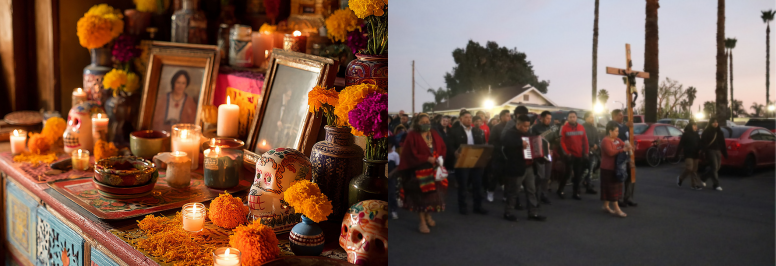By Petra Alexander and Virgilio Nanguce
Mexico:
Mexican culture is steeped in history, roots of faith, and culture that highlight our most cherished traditions. The Day of the Dead invites us to set up altars with marigolds, candles, photos, and perforated paper banners to guide our deceased back home. It's a time to remember our loved ones fondly, share stories, music, and the traditional pan de muerto (bread of the dead). This is just the beginning of our festive traditions as it is followed by the celebration of Our Lady Guadalupe and the Posadas.
On December 12, we celebrate the Our Lady of Guadalupe, a symbol of faith and hope who appeared at Tepeyac and unites millions of faithful in Mexico and abroad. With pilgrimages, songs, and dances, we honor the Virgin who reminds us of our roots and always accompanies us on our journey.
In the Posadas, we remember Mary and Joseph's journey in search of a place to stay. Pastorelas (plays that recount the holy family’s journey) are performed. During these festivities, colorful piñatas filled with candy are broken, Christmas punch and other traditional foods are shared, Christmas carols are sung, and the community gathers together to strengthen family and neighborhood ties.
Mexicans living in the United States find in our two counties countless expressions of our heritage that, in many ways, lessen the feeling of foreignness we immigrants experience. Beyond the Latino presence in culture—cuisine, music, the arts—I believe the deepest root that keeps us alive is family, and in turn, family animated by the values of faith. Although it may seem that Latino families live a simple faith, inspired primarily by popular religiosity, it is actually a root that sustains our identity. It is nourished by experiences and traditions, by searches and struggles, by dreams and realities.
Guatemala:
Guatemala, land of the Quetzal and of the “eternal spring,” a country rich in traditions where the Mayan heritage, Spanish, Mayan, Xinca and Garifuna roots are mixed, present in gastronomy, festivities, art, culture and language (22 Mayan languages, Garifuna and Xinca).
Since the 1980s, thousands of Guatemalans have decided to migrate to the United States of America due to the internal armed conflict in Guatemala. California is the main state where they settled, making it the state with the largest Guatemalan population, with more than one million.
Guatemalan customs are a rich blend of Mayan and Spanish influences reflected in the festivities, most notably Holy Week, which was declared an Intangible Cultural Heritage of Humanity by UNESCO. During this festivity, the faith of the Guatemalans can be seen in the multitudinous processions, where believers carry floats with images of Christ the Nazarene and the Virgin Mary, while bands play their respective marches, walking on carpets made of sawdust.
Another notable festival is the Day of the Dead, which includes the making of giant kites in Sumpango and Santiago Sacatepéquez during the first week of November. This tradition represents the Mayan reverence for the four cardinal points. These kites have a diameter of up to 20 meters, offering a truly wonderful spectacle, and the typical seasonal food called "fiambre," a complex dish of sausages and vegetables. The Christmas Posadas are another tradition that demonstrates Catholic belief and fervor in this activity.
Guatemalans are honest, hardworking, respectful people with strong family and values. Religion is a part of their culture, and food is close to their hearts. Their charitable attitude distinguishes them, offering a helping hand to those most in need. Words like "cabal," "pilas," and "qualidad" are part of their daily vocabulary. Without a doubt, Guatemalans are noble and big-hearted people!
Petra Alexander is the former Director of the Diocesan Office of Hispanic Affairs and Virgilio Nanguce currently works in the Diocesan Department of Life, Dignity and Justice.


